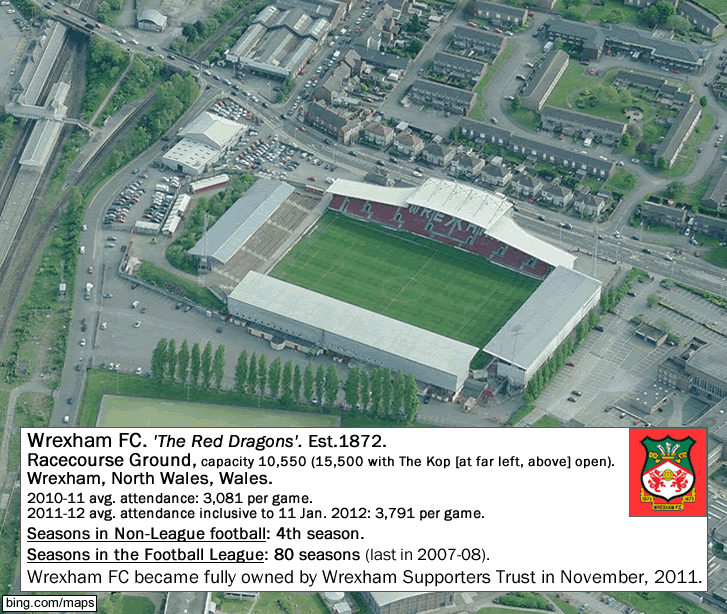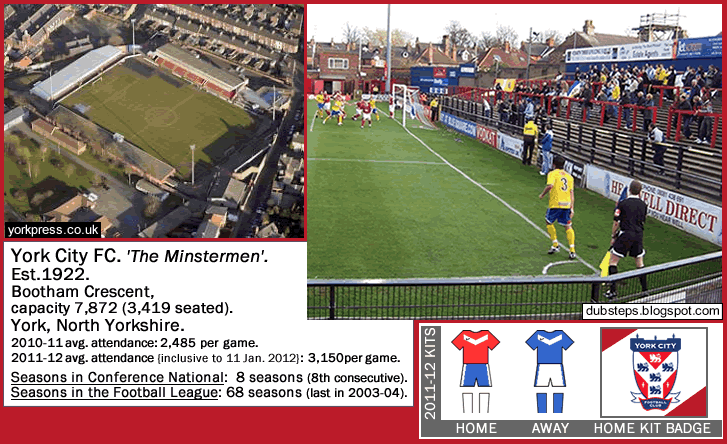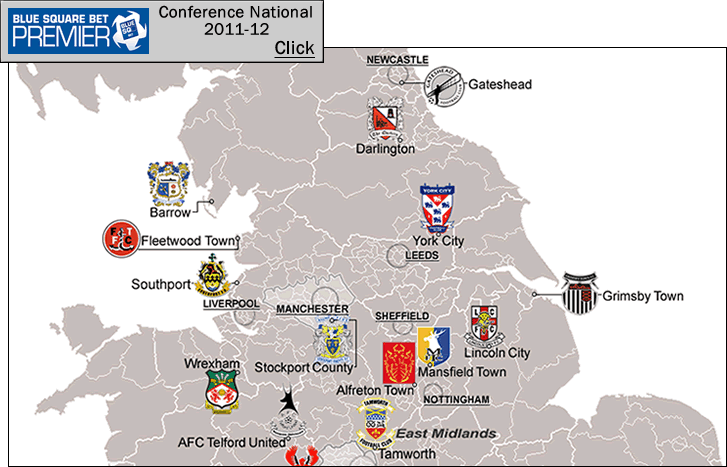Conference National (aka Blue Square Bet Premier League) – results, fixtures, table (Soccerway.com).
…

Photo credit – http://www.fleetwoodtownfc.com/club/highbury-stadium/.
As of 12 January, 2012, coastal Lancashire-based Fleetwood Town occupy the sole automatic promotion-spot and lead the Conference by a point over North Wales-based Wrexham, though the Red Dragons have a game in hand on the Cod Army. Fleetwood made a splash recently with their first-ever FA Cup Third Round Proper appearance, though they fell 5-1 to the second-tier club just down the road, Blackpool. Now Fleetwood, managed by the Scot Micky Mellon, can concentrate on their goal of gaining promotion to the Football League for the first time ever.
Wrexham have plenty of history in the League (80 seasons, last in 2007-08). Since late 2011, Wrexham has become the latest club in Britain to become fully supporter-owned, and they too have made a few headlines recently, being the sole remaining Non-League club still alive in the 2011-12 FA Cup. From Guardian.co.uk, from 11 Januarry 2012, by David Conn, ‘Wrexham hoping FA Cup run can complete Dragons’ rise from the ashes – Wrexham, now owned by a supporters trust, are making headlines for the right reasons again…‘.

Image credit above – bing.com/maps/bird’s eye satellite view.
Wrexham are helmed by player/manager Andy Morrell, who at 37 is still putting balls into the net. Wrexham is seeing attendance up +23% (730 more per game than last season, to a 3,791 per game average). Wrexham’s gates are currently second-best in the Conference. {Attendance figures can be seen at the following link, just above the league table, here (Soccerway.com)}.
…
The biggest draw in the Conference is, for the third straight season, Luton Town, who found themselves relegated out of the Football League following financial meltdown and a 30-point deduction in 2008-09. Luton sit third, 6 points off the pace. Like another recent example of a rather large club to be marooned in Non-League football – Oxford United – Luton Town are finding it very hard to get out of the Conference and back into the Football Legaue. It must drive Hatters fans crazy knowing their club outdraws over 75% of fourth-division clubs [League Two] and over 60% of third-division clubs [League One], but still remain at the wrong side of the bottleneck at the top of the fifth division. Luton are averaging above 6,000 per game once again (6,127 per game as of 11 Jan. 2011), which is a spectacular figure for Non-League football.

Image credit above – bing.com/maps/bird’s eye satellite view.
…
Rounding out the 4 play-off spots are two northern clubs – Gateshead, of Greater Newcastle, in 4th place; and North Yorkshire’s York City, in 5th place. Gateshead’s crowds are not that large for the Conference (where the median figure currently is 1,805 per game)…Gateshead are averaging 963 per game, but that is a +27% increase (an increase of +210 per game).

Image credit above – bing.com/maps/bird’s eye satellite view.
The problem for Gateshead, nicknamed ‘the Heed’ [a Geordie colloquialism for the word 'Head'), is that they play in a dire multi-purpose stadium, the Gateshead International Stadium, that is as charmless as a running track-scarred venue can get. York are drawing well these days (currently averaging 3,150 per game), despite the fact that the Minstermen's ground is inadequate in a different way - their Bootham Crescent (opened 1932) is a relic of a ground that harks to a bygone era. From York City official site, 'Why Not Bootham?'.
Here is a supporters' site dedicated to getting York City a new ground - http://www.astadiumforyork.com/

Photo credits above - yorkpress.co.uk. dubsteps.blogspot.com/2007/11/york-city-havant-waterlooville
That bygone era included no automatic relegation out of and promotion into the Football League, and York City, stuck in the Conference since 2004-05, could be seen as a prime example of a certain type of club - the once-seemingly-permanent-members of the 4th Division who must now labor in the wilds of the Non-League game. Back in the day (before 1986-87), the York Citys of the English football scene didn't really have to worry about losing their League status if they finished in last place, because the old boys' network of club owners would inevitably vote back in last place finishers almost year-in and year-out. In the 29 seasons from when the Fourth Division was formed, in 1958-59, to 1985-86 (which was the last season in the Football League with no automatic relegation out of the League), only three clubs got voted out of the Football League. So the last place finisher (or second-to-last place finisher, see below) in the Football League was spared 26 out of 29 times. It happened to York City in 1980-81, when they finished in last in the old Fourth Division, but were not voted out.
It was only if the club finished in or near last place in the Football League for two or three straight seasons that they risked being voted out - and this occurred with Bradford Park Avenue being voted out of the Football League in 1970, after 3 consecutive seasons at the bottom of the Fourth Division. Present-day Conference National club Cambridge United took Bradford Park Avenue's place in the Football League for the following season [in 1970-71, but CUFC were relegated in 2004-05, after a 36-season spell in the Football League].
The next club failing to be re-elected was Cumbrian club Workington, who were voted out of the Football League 7 years later in 1976-77, after two consecutive seasons at the bottom (and replaced in the Fourth Division for the following season [1977-78] by none other than Wimbledon FC). Interestingly, in that following season of 1977-78, Rochdale finished in last place in the Fourth Division, but 23rd place finisher Southport were voted out instead (Southport had finished in 23rd place for 3 consecutive seasons). The Merseyside-based Southport FC, currently a Conference National club, were the last club ever voted out of the Football League via election. That same election process in 1978 saw present-day Premier League club Wigan Athletic join the Football League, replacing Southport for the 1978-79 Fourth Division season. Wigan had never got a shot at playing League football until 1978-79, and they were a club back then who were able to draw from 4,000 to 6,000 per game [Southport were drawing just 1,873 per game and Rochdale just 1,275 in 1977-78, which were the two worst gate figures in the Football League that season]. Those 4K to 6 K per game figures that Wigan were drawing in their first 4 seasons in the Fourth Division is still higher than most clubs draw in League Two these days. It is an example of a club who was big enough to be in the Football League but for years couldn’t get voted in. One exception, in the other direction, to that state of affairs was Lincoln City, who were voted out of the Football League 3 different times in the early part of the 20th century, but each time were voted back in after just one season in Non-League football. In 1966-67, Lincoln City finished last in the Football League yet were re-elected for the following season. Then in 1986-87, the first season that the Football League allowed one automatic promotion/and one automatic relegation, Lincoln City got the unwanted distinction of being the first club to get the automatic drop to Non-League football.
Now, for the second time in their history, Lincoln City find themselves automatically relegated (along with Stockport County) out of the League [incidentally, Stockport County finished in last place in the Football League in both 1964-65 and 1973-74, and were re-elected both times].
This has added two to the ranks of the clubs with more than 65 years of Football League history that are now stuck in Non-League football. There are presently 8 clubs in this category – Lincoln City and Grimsby Town (with 104 seasons in the Football League each), Stockport County (with 99 seasons in the Football League), Luton Town (with 85 seasons in the Football League), Darlington (with 81 seasons in the Football League), Wrexham (with 80 seasons in the Football League), Mansfield Town (with 70 seasons in the Football League), and York City (with 68 seasons in the Football League). That list will probably expand in future seasons, as newcomers such as Fleetwood Town displace other clubs who have spent multiple decades in the lower divisions of the Football League.
The opening of the barred gate between the 4th Level and the 5th Level in 1986-87 will continue to have the knock-on effect of putting more clubs with no League history prior to 1987 into the Football League, at the expense of down-on-their luck clubs with vast League history. From en.wikipedia.org, ‘Former Conference clubs now in The Football League‘ [21 clubs]. Of the 21 clubs on the list, 13 had no Football League history prior to 1987, and 10 of those are not re-formed clubs (like Aldershot Town, Accrington Stanley, and AFC Wimbledon) and thus are absolute newcomers to the Football League thanks to the establishment of promotion/relegation between the Football League and Non-League football. Those 10 clubs are Barnet, Burton Albion, Cheltenham Town, Crawley Town, Dagenham & Redbridge, Macclesfield Town, Morecambe, Stevenage, Wycombe, and Yeovil Town.
…
The map page featutes a location-map of the 2011-12 Conference national, with 2 flanking sections. On the left of the map page is a chart which shows attendance data and League/Non-League history – total seasons spent by club in the Football League (ie, the top 4 Levels of English football) and in the Conference National (the 5th Level of English football), as well as how the club arrived into their current spell in the Conference, and how many seasons that spell has lasted.
On the right of the map page is a league table chart which shows the clubs in profile boxes arranged to reflect the standings from 11 January, 2012. At that point in time, most clubs had played 27 or 28 games of the 46-game season. The profile boxes feature the club’s home kit badge, their 2011-12 kits, and info on the club including formation date, nickname, stadium name and location, 2010-11 league finish, 2010-11 average attendance (from home league matches), best finish all-time, and seasons spent in the Football League.
…
Scoring leaders in the Conference (as of 11 January 2012)…

Photo credits for above – John Shaw (Gateshead), gateshead-fc.com. Liam Hearn (Grimsby Town), mansfieldtown.net/Gallery. Jamie Vardy (Fleetwood Town), fleetwoodtownfc.com/teams/jamie-vardy. Jason Walker (York City), yorkpress.co.uk. Matt Green (Mansfield Town), mansfieldtown.net/Gallery.
Thanks to the contributors to the pages at en.wikipedia.org, ‘2011–12 Football Conference‘.
Thanks to Soccerway.com for attendance data.
Thanks to E-F-S site for old attendance figures.
Thanks to this set of lists on the Football365 site – Club’s all-time season by league level [Levels 1 through 4, from 1888-89 to 2001-02].
Thanks to the Footy-Mad.co.uk sites, for their League History charts of each club {Levels 1 through 5], usually found at top menu bar under Club/League History; example, http://www.wrexham-mad.co.uk/.

